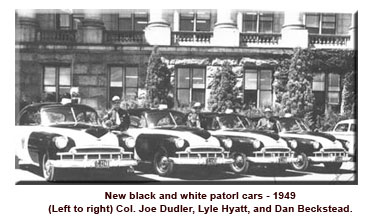Colonel Joseph W. Dudler
Colonel Joseph W. Dudler set many goals for the Utah Highway Patrol. First, he wanted to coordinate all radio equipment of state and local law enforcement agencies to create an integrated network. To accomplish this task, the radio call signs of the Patrol were changed in March 1950 from KUHP to KOB 218. At this time approximately 50 percent of the Highway Patrol cars were equipped with radios capable of both receiving and transmitting. The remaining 50 percent could receive only. In addition, the Patrol purchased their first “walkie-talkie” radio in 1950. As was mentioned in the previous chapter, the dispatch center located at the State Capitol began operating on a 24 hour basis. By 1951 radio communications were completed, linking Salt Lake, Price, Moab, Vernal, and Richfield. By 1952 all patrol cars had been equipped with radios capable of receiving and transmitting.
Second, all officers received advanced training in first aid. This program was called the “Red Cross on the Highway” program. All troopers completed advanced Red Cross first aid training. Officers were also issued additional first aid equipment.
Third, the Patrol began closer coordination with the State Road Commission, the Tax Commission, the Fish and Game Commission, and the Civil Air Patrol. The walkie-talkie radios were first used in search and rescue missions with the Civil Air Patrol. The Ute Rangers were designated as the official mounted posse of the Utah Highway Patrol and assisted in search and rescue efforts, as well as performed during parades and rodeos. The Patrol also assisted several law enforcement agencies throughout the state. One of the first such duties under Colonel Dudler’s command was assisting Carbon County and Price, Utah, during a coal miners’ strike in 1950.
Fourth, Colonel Dudler began an active campaign to increase the field strength of the Utah Highway Patrol. After reorganization in 1949, the Patrol consisted of eight sergeants and 42 troopers/patrolmen. By June 30, 1952, that number had increased to 10 sergeants plus 66 troopers/patrolmen.

